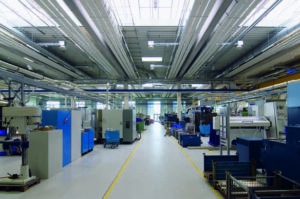Ceiling-mounted radiant heating panels and sails arguably have significant advantages over alternative forms of heating. From energy efficiency to easy maintenance, here are five reasons why radiant panels are a smart choice for your next building project.
Energy efficiency
Radiant panels are a great way of providing comfort without expending large amounts of energy; because heat is delivered only where required, energy waste is minimised. Rather than heating the air, radiant panels warm only the solid objects in their line of sight, such as furniture and people, minimising fabric and filtration losses on outer walls and ceilings.
When heating, energy consumption is 15% lower than with radiators. Comfort is delivered at lower air temperatures than with radiators, meaning lower energy consumption and lower heating costs. For example, if room air temperature is 18⁰C, radiant heating panels typically make it feel like 21⁰C.
Thermal comfort
The ultimate aim for any provider of heating and cooling solutions is comfort: Regulating the air and heat supply to make sure the room is kept at an optimum temperature and occupants are not too hot or cold.
With radiant panels, the technology ensures fast response times to changes in heating load demands and other factors affecting the temperature of the room, meaning that comfort levels are delivered quickly. In addition, radiant panel systems are easily zoned, so that each room can be adjusted to individual comfort levels without the need for structural insulated partitions.

Radiant ceiling panels
Safety and hygiene
With air quality moving further up the agenda due to a focus on air pollution, it’s vital for developers and building services professionals to ensure that Indoor Air Quality (IAQ) is at its best possible level. With radiant panels, the air is healthier than with forced-air systems because there’s no distribution of dust, pollutants, bacterium or viruses.
What’s more, as the panels are at ceiling-height, they are out of harm’s way. There’s no risk of people bumping into them, user interference or getting burned –there’s no wear-and-tear on the heating surfaces in high traffic areas. In terms of hygiene and maintenance, the smooth-surfaced panels are easy to keep clean.
Flexible solutions
One of the selling points of radiant panels is the fact that they come in so many different styles, sizes and installation formats. The panels can be integrated with the ceiling so discreetly that they’re barely noticeable, or can be shaped or coloured to make a bold design statement.
To heat the water that flows through the panels, radiant heating panels can be connected to alternative energy sources, such as biomass boilers, solar panels and heat pumps or combination of all of these.
Radiant panels can also integrate additional services. Lighting is a popular choice, but there’s also the option of designing in acoustics, speakers, fire alarms, and sprinkler heads.
They also cool
As the radiant panels are universal, they can provide both heating and cooling. This is an advantage both practically and in terms of cost and energy efficiency, as one set of panels can serve a dual purpose.
Twitter:@ Zehnder_UK @Bisqueradiators
LinkedIn: Zehnder Group UK Ltd Bisque Radiators
Website: www.zehnder.co.uk

